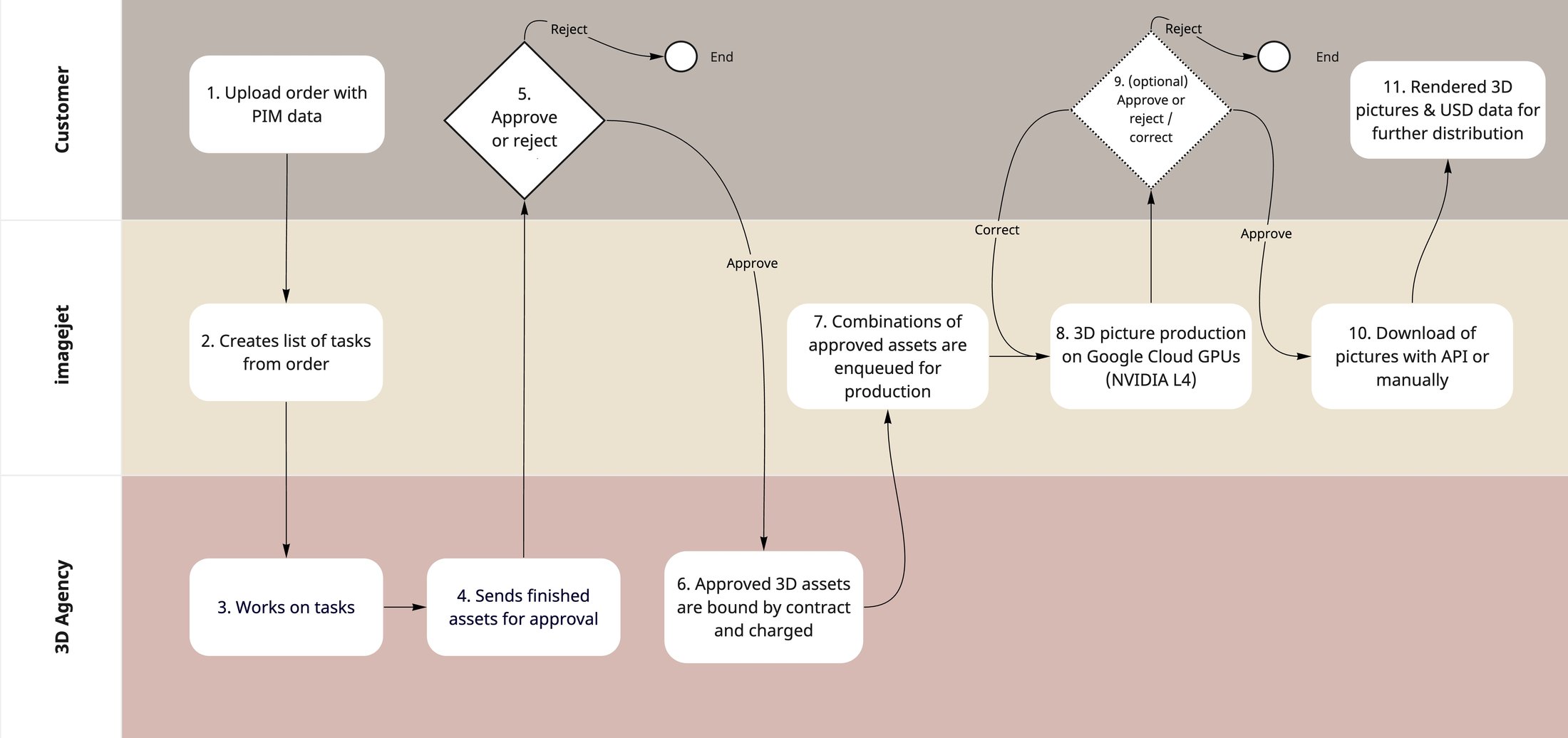How Arvato Systems makes 3D picture production easier, faster and cheaper with Google Cloud
Götz Moritz Bongartz
Product Owner of imagejet, Arvato Systems
Benjamin Storz
Principal Architect, Google Cloud
With the rise of ecommerce and digital business models, the need to create high-quality, photorealistic 3D pictures continues to surge. Today, the way brands photograph and style their products can play a huge role in purchase decisions. Some 87% of consumers say that product pictures are very important when making a purchase decision online while another 67% say the quality of product images is very important in their purchasing decision. In fact, according to recent research, more customers value the quality of a product’s image than they value product-specific information (63%) or long descriptions (54%).
Imagine viewing your new living room couch from a realistic 3D perspective, complete with rich details such as texture, lighting, and accessories that match your preferences. These 3D assets can be used not only for image production but also potentially for augmented reality (AR) and virtual reality (VR) use cases and scenarios.
Google Cloud Premier partner Arvato Systems developed imagejet to deliver 3D picture production. The new innovative cloud-based solution leverages G2 VMs powered by NVIDIA L4 Tensor Core GPUs and offers organizations easy entry for creating high-quality mass picture production with photorealistic studio quality.
Challenging the status quo and surpassing traditional boundaries
Due to the online shopping boom in the post-COVID era, there has been an unprecedented demand for first-class product presentation experiences that use studio-quality images. To keep pace, retailers, consumer packaged goods companies, manufacturers, and other small and medium businesses are now extending their go-to-market strategies into online channels and need a way to present their products more professionally.
Traditional product photography is quickly reaching its limits; it’s costly, inflexible and less dynamic, and lacks scalability. Taking high-resolution images of products requires a studio setup with expensive equipment and lighting to capture just a few scenes. We offer few options for capturing a broad range of product textures, colors, and materials. This approach does not scale with the rise of product variants and market or trend dynamics that require rapid product adaptations.


Photo Studio setup with product photography equipment
On the other hand, building a powerful 3D rendering platform from scratch requires significant investments in development efforts and infrastructure, such as acquiring powerful NVIDIA graphics processing units (GPUs) and costly third-party software licenses for 3D rendering software.
Building an image product pipeline takes tremendously high effort. For many organizations, it’s an undertaking that is out of reach, especially given the high costs and technical complexity. Furthermore, image production with in-house builds or traditional product photography-based approaches is much slower, delaying time to market and making it much more difficult for teams to react quickly to market changes.


Example 3D rendering output using imagejet


Example 3D rendering output using imagejet showing rich details of texture and illumination
How imagejet improves the 3D picture production process on Google Cloud
Arvato Systems developed imagejet to significantly accelerate the 3D picture production process. The goal was to lower the bar of access to 3D production pipelines for customers while also reducing costs and complexity.


Imagejet workflow
Imagejet provides the following key capabilities:
- Streamlined picture production based on 3D assets without requiring any change of existing photography workflows
- A collaboration platform to connect teams (customer, 3D agency)
- Integrated approval and workflow management
- Fully scalable production and high throughput of picture generation (on Google Cloud), leveraging key standards like Pixar’s Universal Scene Description (USD) and industry standard Product Information Management Data (PIM)
- Single source publishing — one asset type — across multiple distribution channels (e.g. AR/VR applications)
For example, imagine you have a customer that requests 4 million pictures for his product catalog. Using imagejet with dynamic workload distribution on Google Cloud NVIDIA L4 GPUs and optimized spot instances), you could deliver the requested assets in just two weeks. The same request would take almost two years to complete with an in-house or on-premises 3D production pipeline.
Partnering with Google Cloud for more innovation
When Arvato Systems started building imagejet, the team knew it needed a cloud partner that could offer a broad range of state-of-the-art technology and strong technology partnerships with key market players. Google Cloud’s strategic partnership with NVIDIA ensures that Google Cloud customers have access to the latest GPUs and solid capacity. In addition, Google Cloud provided other key services to improve performance, such as Google Kubernetes Engine, Pub/Sub, Cloud Storage, Cloud memorystore for Redis and BigQuery.
Through strong collaboration with the Google Cloud Customer Engineering team, Arvato Systems was able to identify that NVIDIA’s L4 Tensor Core GPUs offer the best performance for its 3D rendering workloads, which require heavy 32-bit (floating point) operations. Using the latest NVIDIA L4 GPUs allowed Arvato Systems to improve imagejet’s 3D rendering performance by 160% and reduce rendering costs by 75% — a significant improvement to the previously tested NVIDIA A100 Tensor Core GPUs.
"In our work with Arvato Systems, we have not only pushed technological boundaries but also made a stride toward lowering energy consumption. By using NVIDIA L4 GPUs on Google Cloud, we have significantly improved the energy efficiency of our 3D rendering processes,” said Anna-Maria Martini, Google Cloud’s head of customer engineering for Media and Entertainment. “This is a testament to how advanced technology can not only boost performance but also play a crucial role in reducing the ecological footprint, an aspect increasingly important in the digital world."
Beside an excellent cost-performance ratio and consistent availability of required capacities in the EU region, Arvato Systems also benefits from access to the wider ecosystem of Google Cloud products and services. imagejet takes advantage of the high scalability of the underlying Google Cloud infrastructure to accommodate multiple 3D mass production jobs, reduce technical complexity, and lower labor costs by offering a flexible utilization-based pricing approach to its customers.
Delivering high quality 3D picture production in an easier and faster way
The development of imagejet marks a key milestone in how businesses can transform and enhance their product presentations, which are now a fundamental part of their business models. With the continuous advancement of cloud technologies and the increasing demand for immersive and more interactive shopping experiences, imagejet offers a new way of working that makes high-quality 3D picture production faster, more innovative, and more cost-effective.
“Thanks to Google Cloud, our solution imagejet will revolutionize the way artists, agencies, marketing departments, gamers, developers and more work,” said Christian Scholz, Arvato Systems’ VP of Cloud and Business Transformation. “We give our customers compelling tools so they can bring their power together and create virtual worlds.”
For more information, we also recommend the following resources:
Thanks to Anna-Maria Martini and Christian Scholz for contributing with their insights to this post.



